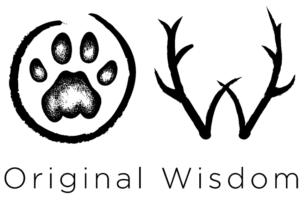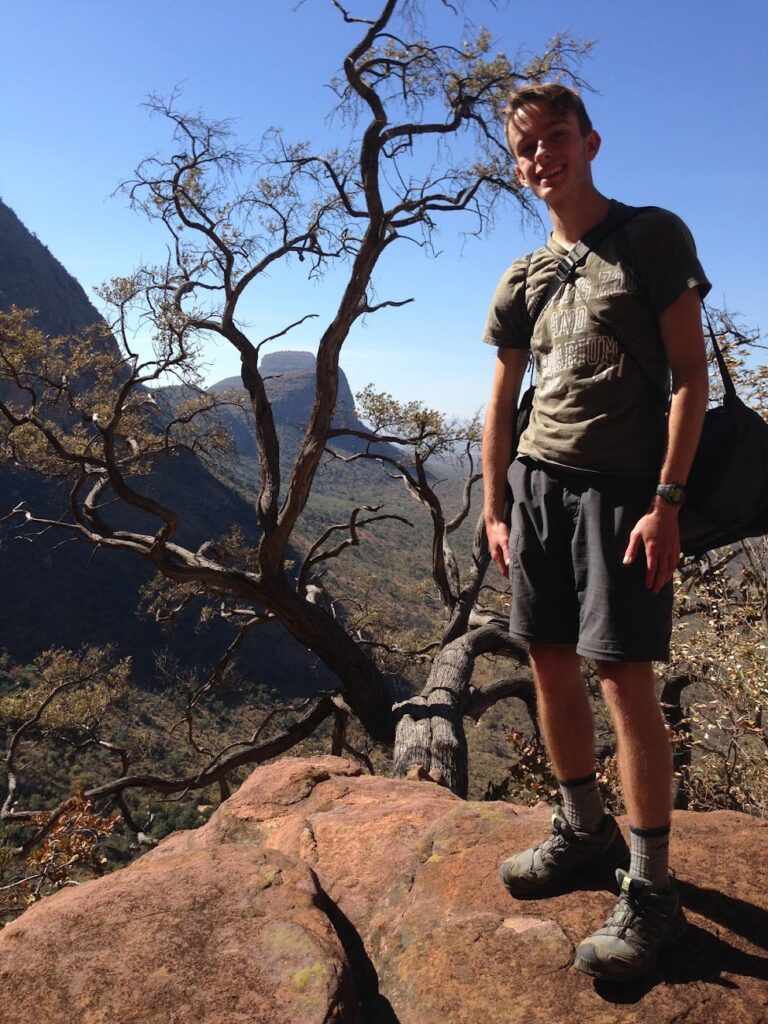Tracker Tuesdays – Week 9
Answers to our Daily Tracking Challenge
This is a time to create and share content that engages, entertains, educates and inspires the world.
HEADS UP, TRACKERS! Even though we aren’t out of the proverbial “woods” yet with this coronavirus pandemic, I need to start transitioning away from a #DAILYTRACKINGCHALLENGE. While I’ve enjoyed the interaction and the learning very much, it takes a lot of time to do this, and is difficult to do from the bush with limited wifi. Therefore, starting this week, with Week 10, we will be transitioning to a one-question-a-week format, on #TrackerTuesdays, and the answers will be published on the first Tuesday of every month in our Newsletter. Many thanks to everyone who has participated so far, and let’s keep going!
Answer list: African wildcat tracks from the Republic of South Africa; bark beetle galleries from Poland; black rhinoceros tracks from the Republic of South Africa; domestic cat tracks from New England in the USA; hippo skull from the Republic of South Africa, white rhinoceros tracks from the Republic of South Africa
The art and science of tracking develops creative and critical thinking skills, and curiosity and empathy, which also help us to better understand our place as caretakers of this beautiful world. The full expression of tracking includes more than just identifying tracks and signs. It also includes the interpretation of behaviours from tracks and signs, and the following and finding of animals (or people) using tracks and signs. Following and finding, or trailing, also builds confidence and leadership qualities in individuals, and teamwork among groups. Tracking requires us to really see the environment, and each other, and to reconnect to fundamental systems of living, which include knowledge of self, and connection to community (including non-human communities) and land. Tracking IS original wisdom. It’s both ancient, and new. Our ancestors tracked animals for food, clothing, shelter, and better quality of life. Today, we push the frontiers of tracking forward by including technology and new discoveries. One of the best things about tracking is that the “book of nature” is so vast that we can never know it all. It’s always exciting and always humbling.
Wednesday, 3 June 2020
Our question today comes from our Ngala Training Camp in the Greater Kruger area of the Republic of South Africa (RSA). Who’s tracks, and which feet?
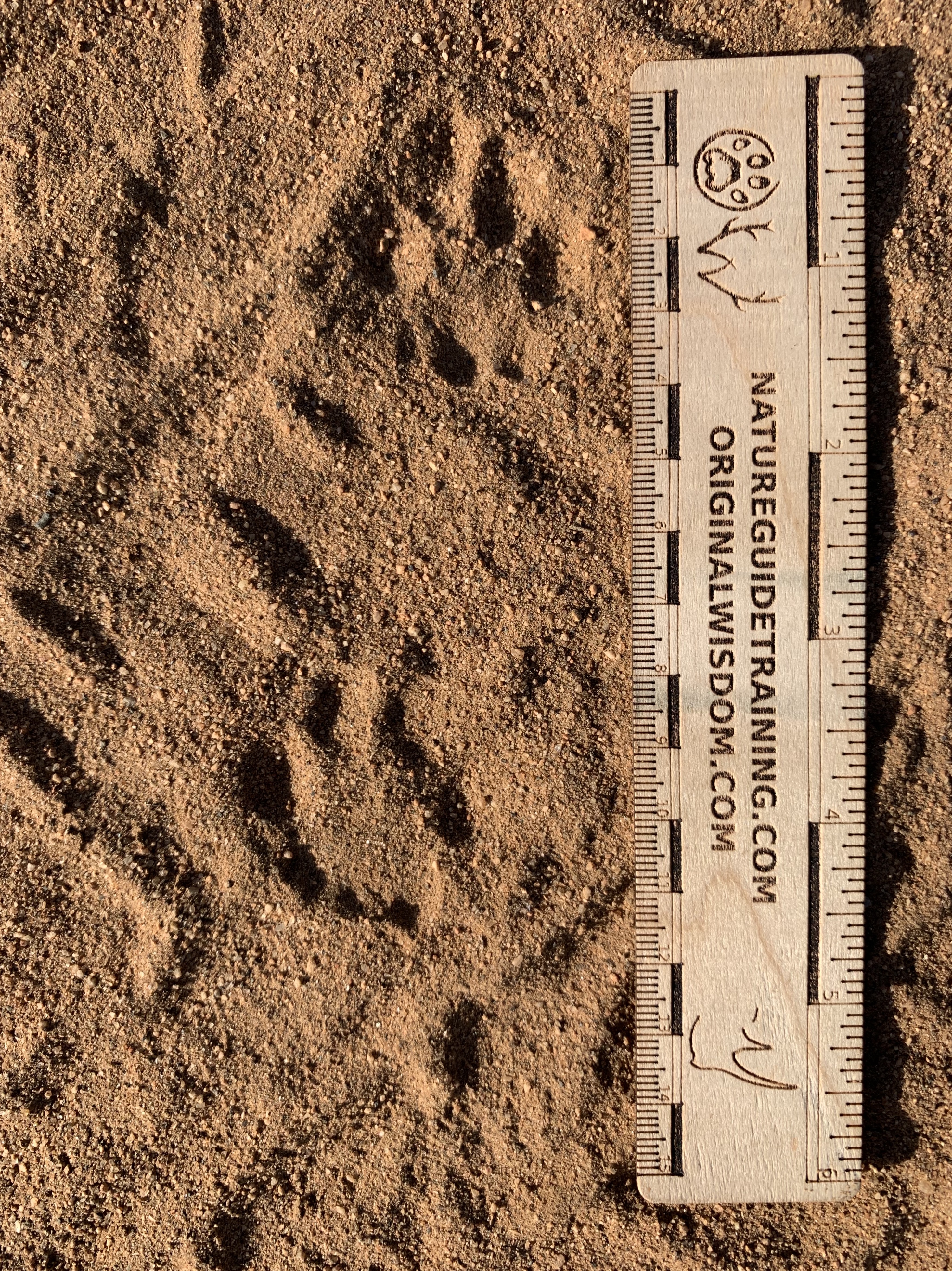
African wildcat tracks, front on the bottom and hind on the top, in South Africa, photo by Kersey Lawrence
Mike Watling (California, USA) noted, “I see classic Felid characteristics; tri-lobe posterior, “C” shaped negative space, hind track (on top) narrower than the front, tear dropped shaped toes, leading toe 3, plus the size.” He concluded, along with Frikkie Kotze (South Africa), David Kennedy, Chuggy Charles (UK), and Catherine Albertson (USA), that these were African wildcat tracks.
African wildcats are the ancestors of domestic cats, and can hybridize with them, which is problematic in the bush, both for trackers who wish to tell the tracks apart, and for the wild species. Frikkie, Chuggy, and Catherine also further identified that the bottom track is the front foot track, and the top track is the hind foot track. Chuggy added that because the hind foot is overstepping the front, this makes it an overstep walk, so the animal is moving quickly. David added that the central lobe of the posterior of the track is slightly larger that the two side lobes, which is also a characteristic that we see in this species.
Thursday, 4 June 2020
Our question today comes the Białowieza National Park in Poland, from our epic adventure with CyberTracker Track and Sign Specialist Dan Hansche owner of the eco-tourism company Spur Wander (https://www.spurwander.com/) in February this year. Who’s sign? Feel free to guess, but your answer should include your reasoning behind how you know.
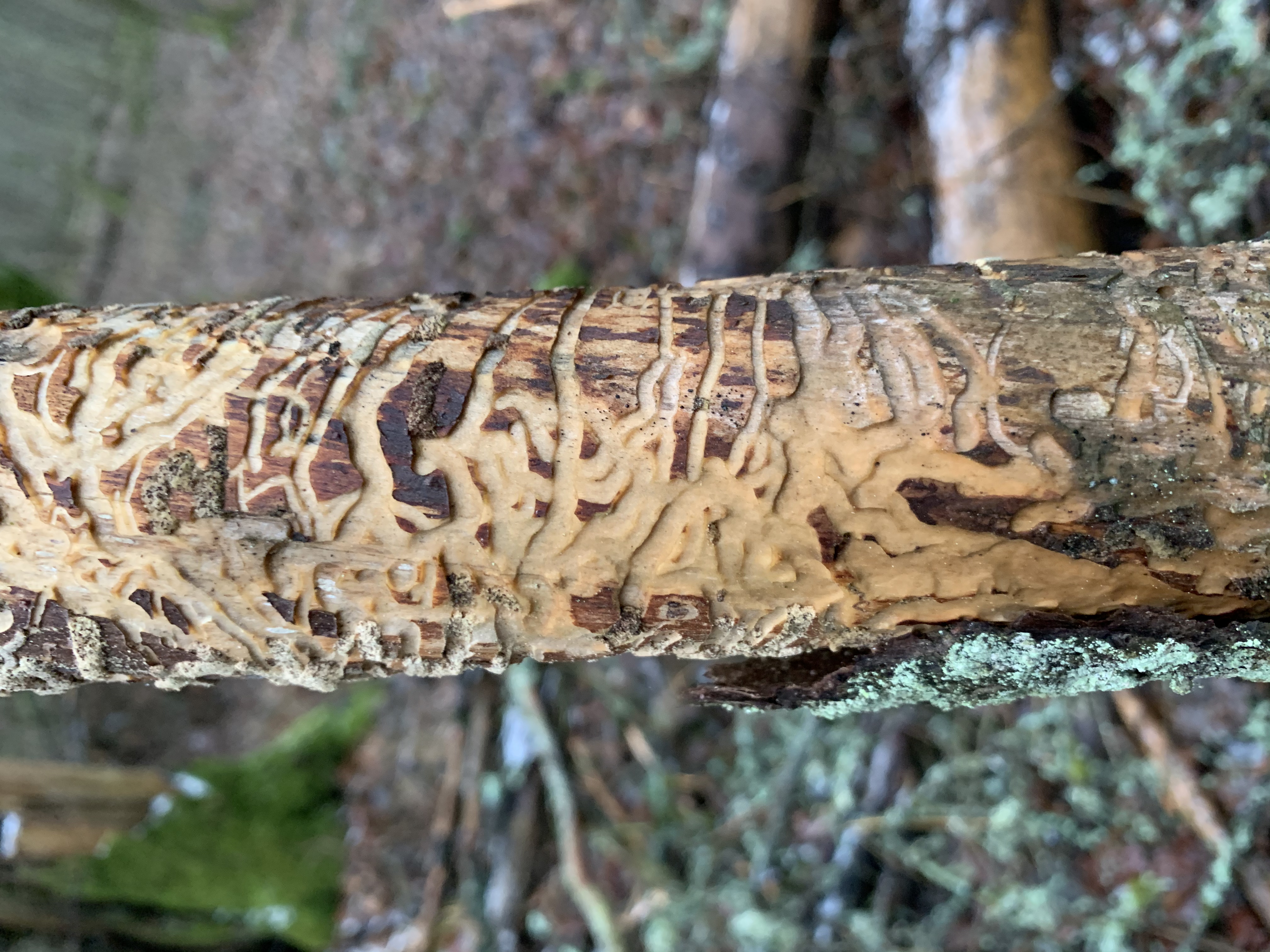
Bark beetle galleries from Poland, photo by Kersey Lawrence
Both David Kennedy and Mark Apgar (USA) correctly called these larval beetle galleries. I lean towards Buprestidae, but I’m not 100% sure what group of wood-boring beetles they are. There is some info, below, from Charley Eiseman and Noah Charney’s book, Tracks & Signs of Insects and Other Invertebrates – A Guide to North American Species.
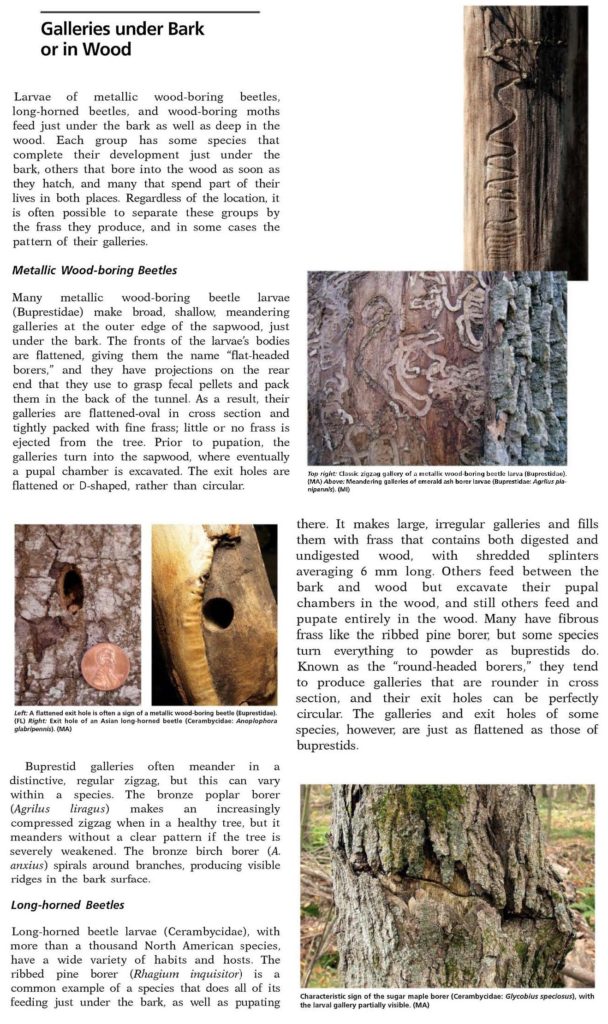
Friday, 5 June 2020
Our question today comes from the Republic of South Africa (RSA). Who’s tracks (the big ones next to the ruler, although you can attempt the others, too, if you want), and what international significance do they have?
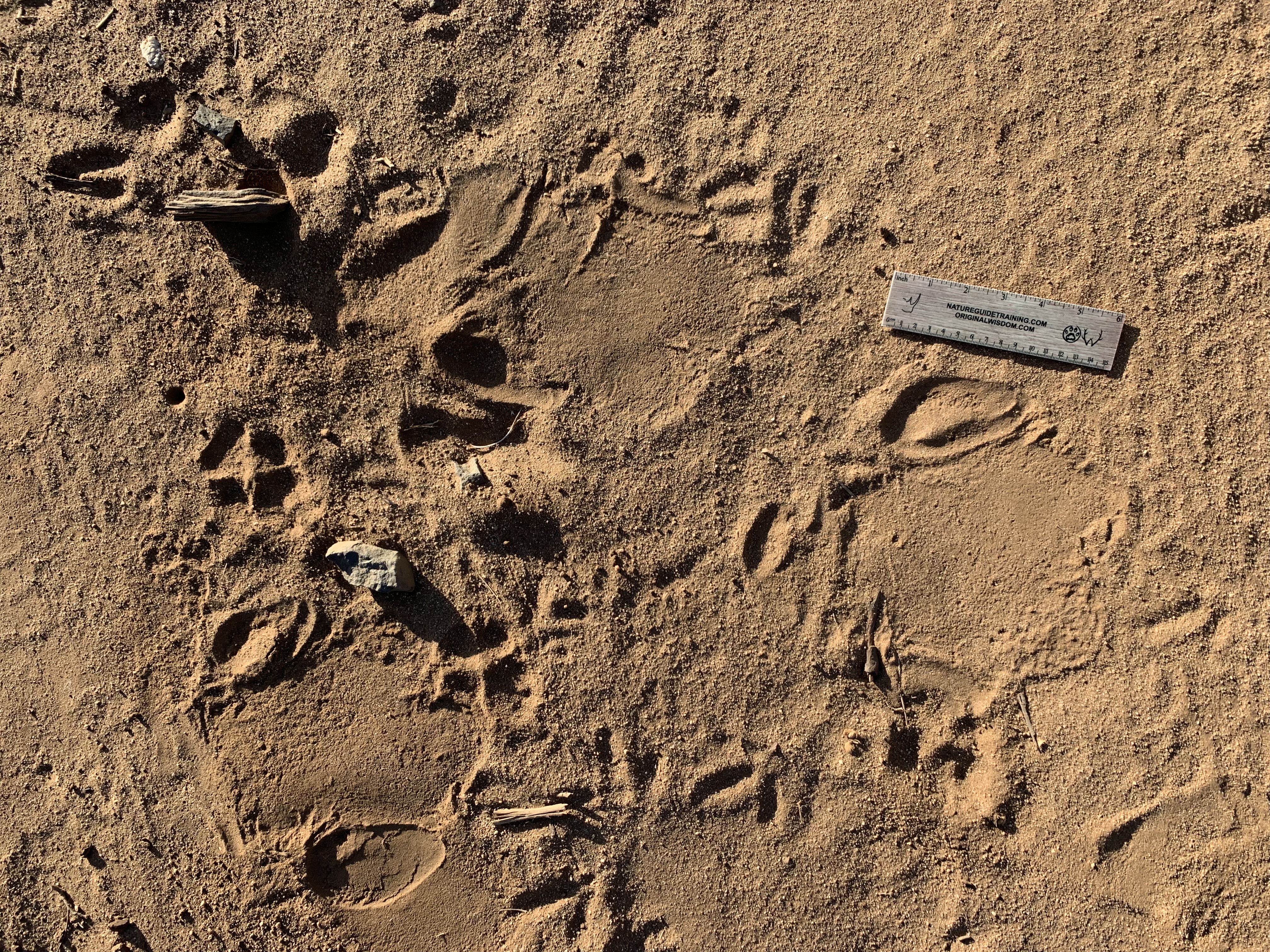
A black rhino bull’s tracks in South Africa, photo by Kersey Lawrence
Lot’s of great answers here by Mark Apgar (Connecticut, USA), Mike Watling (California, USA), Frikkie Kotze (South Africa), Nico Kritzinger (South Africa), and Cameron Pearce (South Africa).
The large tracks in question are black rhino tracks. Nico and Cameron noted that the front toe is farther from the side toes than in a white rhino, and the track is smaller than a white rhino, at approximately 20 cm. Cameron gave the most detailed anwer, with “Black rhino ? Just over 20cm in size (smaller than white rhino), not much of an indentation at the back of the foot, relatively smooth surface with few cracks on underside of foot and finally a larger gap between the middle and side hooves.”
Mike also got the wild dog tracks, a classic canine track. Nico got the impala tracks, a sloppy walking, heart shaped track. The bird tracks were guineafowl, our largest “game bird” species where this occurred.
The international significance of these tracks is that there is a “war” going on in Africa, where poachers are illegally killing all rhinoceroses for their horns in brutal ways and at a rate that is much faster than rhinos can replace themselves and than anti-poaching units can prevent, apprehend, and bring to prosecution. A rhino dies every 8 hours in Africa, because it’s horn, which is made of keratin like your fingernails, is thought to cure cancer in Chinese traditional medicine (it doesn’t, and has been medically proven not to), and there is a huge, profitable, illegal, heartless, business revolving around their brutal slaughter. Stroop is an amazing movie on YouTube about the plight of rhinos, but very sad, and long. It’s about 2 hours and 20 minutes, so plan accordingly. The movie is intended to raise awareness about the huge problem that exists for rhinos, and some of the facets of it. At the rate they are being poached, rhinos will be functionally extinct in the wild within 10 years, and yet most of the world is blissfully unaware of the problem.
Saturday, 6 June 2020
Our question today comes from Connecticut in the New England area of the USA. Who’s tracks, and can you tell which feet are which, and how is the animal moving?
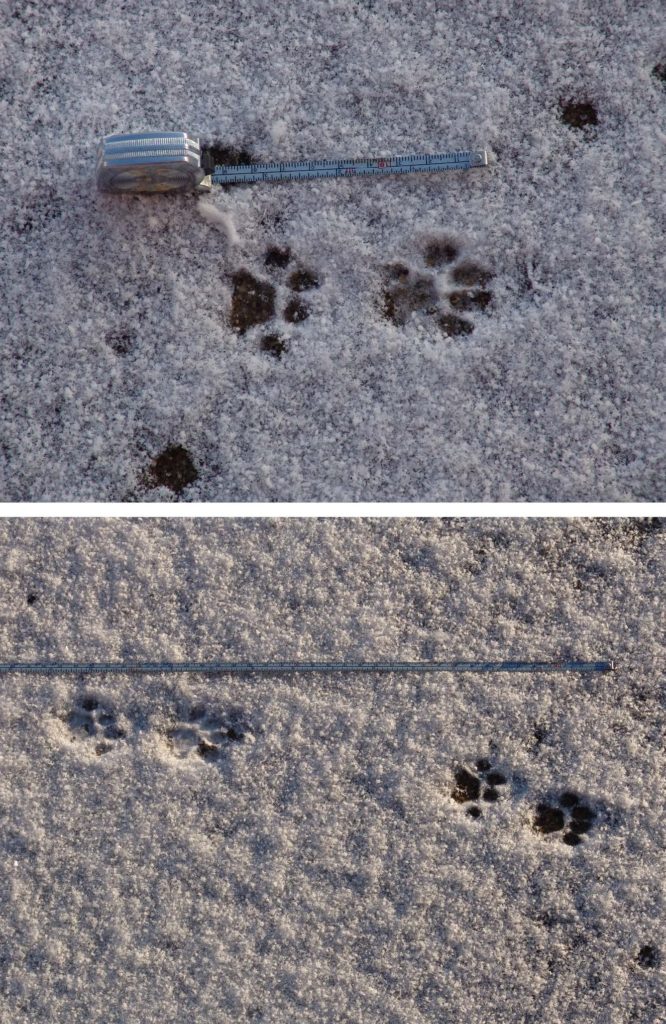
A domestic cat’s tracks in an overstep walk in a light snow in Connecticut, USA, photos by Kersey Lawrence
Paul Glasser (USA) gave a comprehensive answer to these photos, it’s a domestic cat. You can scroll back and compare it to the African wildcat tracks from earlier in the week, Paul said, “Domestic cat overstep walk. These are feline tracks because of the asymmetric arrangement of toes around the heel pad, and because the heel pad shows three in the rear. I‘m calling it a domestic cat (although could be juvenile bobcat) because the tracks are too small for adult bobcat. In the first photo the track on the left is right front and the track on the right is right hind. These are right tracks because the leading toe is on the inside. The track on the left is front because it is blockier amd more round than the hind. Correspondingly, the track on the right is hind because it is more oval. Also, felines commonly walk with an overstep. In addition, I will go out on a limb and apply Elbroch’s criteria for sexing cougar tracks (p.22 2nd. ed.) and call this is a male because the front track is wider than long, while the opposite is typically true for the female frront track. This is also true for bobcats so from my view out on a limb I speculate that it is true for domestic cats as well. Maybe someone can confirm one way or the other? The second photo, from left to right, is LF, LH, RF, RH, by the same reasoning as above.”
Many people thought these were bobcat, lynx, or mountain lion. They are just too small.
Sunday 7 June 2020
Our question today comes from our Ngala Training Camp in the Greater Kruger area of the Republic of South Africa (RSA). Who’s skull? It’s many times bigger than my ruler, which isn’t even shown.
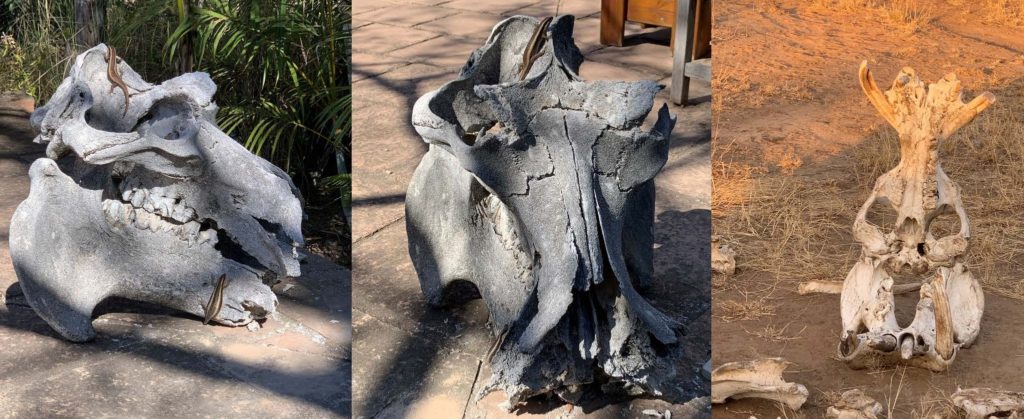
A hippo skull (two different ones, actually) from South Africa, photos by Kersey Lawrence
Nico Kritzinger (South Africa) and Elle van Dijk (Netherlands) got this one correct. Elle said, “An animal that has eyes (and ears) more on top of the head as you can see. And I recognize the canine teeth… It’s a hippo. The eyes, ears (and nostrils) are more on top of the skull so they can be mostly submerged and still see, hear and breathe.”
Monday 8 June 2020
Our question today comes from the Republic of South Africa (RSA). Who’s tracks, and what international significance do they have?
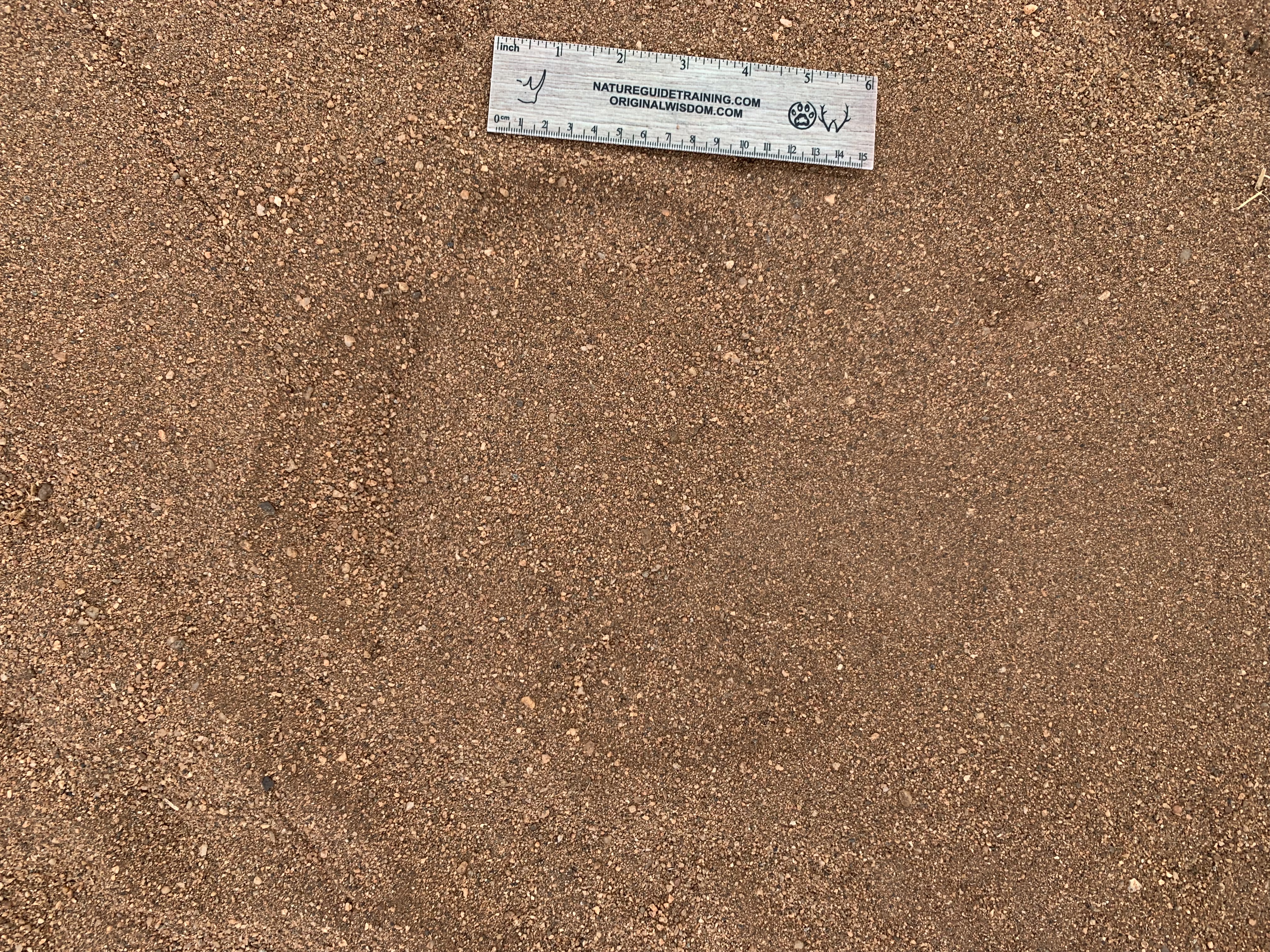
A white rhino’s track, in South Africa, photo by Kersey Lawrence
Osekimasaimaracamp and Stuart Wedge got this one correct, it’s a white rhino. You can scroll back and compare it to the black rhino track from earlier in the week. Stuart said, “white rhino. Large size, front toe close to foot, last stronghold of the white rhino on the planet.”
What Stuart meant, I think, by “last stronghold of the white rhino on the planet” is that South Africa, specifically Kruger Park, has been busy pushing rhinos into more secure areas, where they can be protected from poachers. It’s estimated that there are less than 20,000 white rhinos left, and less than 3000 black rhinos.
I’ll put the info about rhinos and STROOP, here, again, because it’s so important.
The international significance of these tracks is that there is a “war” going on in Africa, where poachers are illegally killing all rhinoceroses for their horns in brutal ways and at a rate that is much faster than rhinos can replace themselves and than anti-poaching units can prevent, apprehend, and bring to prosecution. A rhino dies every 8 hours in Africa, because it’s horn, which is made of keratin like your fingernails, is thought to cure cancer in Chinese traditional medicine (it doesn’t, and has been medically proven not to), and there is a huge, profitable, illegal, heartless, business revolving around their brutal slaughter. Stroop is an amazing movie on YouTube about the plight of rhinos, but very sad, and long. It’s about 2 hours and 20 minutes, so plan accordingly. The movie is intended to raise awareness about the huge problem that exists for rhinos, and some of the facets of it. At the rate they are being poached, rhinos will be functionally extinct in the wild within 10 years, and yet most of the world is blissfully unaware of the problem.
Thanks to everyone who participated. Let’s keep learning together! If you have photos (with an explanation that you’d like to contribute), please contact me at kersey@originalwisdom.com – your contributions will be credited to you.
#trackingisoriginalwisdom, #natureguidetraining, #cybertracker, #trackercertification, #trackermentoring, #alwaystracking, #environmentaleducation, #ecologicalliteracy, #ecologicalintelligence #wildlifetracking, #animaltracking, #tracksandsigns, #systemsthinking, #ecology, #nature, #science, #conservation, #sustainability, #resilience, #adaptation #thinkinglikeamountain #weareallconnected #BeMoreNeedLess #trackinginafrica #greaterkruger
Download our recommended reading list for trackers by signing up for our “News for Trackers” newsletter!
Our goal is NOT to be spammy with our newsletter. We’d just like to send occasional updates on upcoming programs and maybe some cool info on wildlife, people, and tracking!
Once the sign-up form has been submitted, you will be re-directed to the download page.
Download our recommended tracking book list (and some other resources). It’s specific to Southern Africa and North America, but, a good tracking book is helpful in any region as a starting point to learn how to look at track morphology and animal behavior.
[contact-form-7 id=”2892″ title=”Subscribe to the newsletter”]
